|
BELFAST : The Capital.
BY ALFRED S. MOORE.
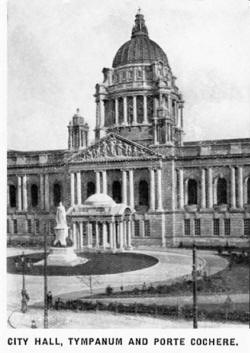 |
 |
|
CITY HALL |
ROYAL AVENUE |
BELFAST'S name�Bel, an entrance or ford ; Fearsad,
a sandbank�bespeaks its origin, and the fateful opportune linking up of
the present City Hall with Donegall Square and Chichester Street
epitomises its development past and present. What Garden of
Remembrance more fitting, then, than the City Hall Gardens�the old-time
cherry garden of Belfast Castle only 150 years ago�to recast the
apotheosis of an obscure hamlet into quadruple honours as�(l) the
Capital of Northern Ireland ; (2) the eighth city in the British Isles ;
(3) the United Kingdom's sixth port ; and (4) the world's leading linen
centre ? All achieved within three much interrupted centuries. In 1603
Belfast's only feature was the ford across the Lagan (near the present
Queen's Bridge), communicating between the Antrim and Down counties.
With the flight of the Irish Earls their forfeited estates went to
English and Scotch planters whose fealty to James I. was less suspect.
So in 1603 came to Arthur Chichester, a Devonian, the lands of Belfast
(also known as Ballycooregalgie). As Governor of Carrickfergus, then the
great English stronghold in Ulster, he was further donated a life
pension of 13/4 per day. Indeed without this financial supplement
Chichester might probably have refused Belfast. Thus he wrote when I
have them (the lands of Belfast) in perfection I will gladly sell the
whole lands for �5 fee simple." And to-day the rateable value of the 25
square miles area of Belfast, so contemned by Chichester is almost
�2,000,000. Moreover, the Harbour Revenue alone approximates �300,000
yearly. Under Chichester�later ennobled as Earl of Donegall (and so
the relic of the latter name in Donegall Square, Place, Street,
etc.)�Belfast was governed in nigh feudal style. Nominally, a patent in
1613 granted it a Corporation and Sovereign (mayor) with privilege to
return two members to the Irish House of Commons, but Chichester
overswayed all. Carrickfergus was the chief port, too, and held
pre-eminence until deprived of its Customs monopoly. Thereby Belfast
benefited and began as a port. The little town on the Lagan had
multifarious juvenile adversities and made slow progress during the 17th
and much of the 18th century, but mind rules matter�and mentality meant
much in Belfast's building. The north-east corner of Ireland has
produced men in the front rank out of all proportions to her numbers" ;
and a plausible explanation, says Dr. Murray, is the cross-fertilisation
of cultures. Many strains find conflux in Belfast character�Irish,
Scottish, French, Huguenot and German. All have fused, evolving a
distinct type ; independent, sturdy, pushful and, above all, determined.
" Impossible" is not in their lexicon. Against all economic postulates
they have won supremacy in ships, linen, tobacco, ropes and other
products�all exotic manufactures in the sense that almost every ounce of
the raw material is imported. Simultaneously, natural obstacles have
been conquered ; Belfast's city and its spacious docks have risen
literally from the mud of its meandering river. The rise and fall of the
tide is pencilled in the subsoil only six feet down. Hence, all
Belfast's magnificent modern edifices�in fact any erection except a
cottage�have as foundations piles many feet deep. To make their spacious
harbour the Belfastians carved and channelled the mud as a child does on
the shore. So has been achieved access at all tides to great ships
drawing 30 feet to quayage extending seven miles, and with dock railways
of 13 miles, linking up every district in Northern and central Ireland.
Thus Belfast is Ulster's ocean gateway. If the 17th and early 18th
century constituted Belfast's belated boyhood the latter 18th century
symbolised its rapid adolescence. The open river which ran down High
Street was gradually covered over though Bridge Street still remains
reminder of the once-was. Village ways were scrapped. Yea, with its
great and ever increasing fleet of ships�locally built and
owned�prosperous commercial contact was made with over-seas, especially
with United States and West Indies. Public libraries and charities
began, and Belfastians led in the democratic clamour for freedom of
individual thought and conduct. Gaze to-day at the planning, so
liberally direct and regular, of the streets in the City Hall
vicinity�Donegall Square, Wellington Place, Chichester, May and Howard
Streets �and you may estimate the culture and vision of those later 18th
and early 19th century Belfastians, Pari passu the population
progressed. The 2,000 at the end of the 17th century (which had grown
from less than 500 at the end of the 16th century) multiplied to over
20,000 at the end of the 18th. Albeit, even then Belfast was, in
population, only fifth among Irish towns, Dublin, Cork, Waterford and
Limerick having more inhabitants and wealth.
 Belfast marked its
majority in the 19th century ; it was only created a city in 1888. What
would be its gesture to the advent of industrialism ? Its industries
were domestic and handicrafts. Curiously, too, although to-day Belfast
is the world's Linenopolis, it had only half a dozen linen looms in
1810. Cotton ruled, with 860 looms clacking. Mass production would
inevitably extinguish manual. So with characteristic Belfast prescience
the Mulhollands re-equipped in 1830 their burnt-down Cotton Mill for
spinning flax by steam. The venture succeeded, and is to-day the great
York Street Linen Mills. Power weaving was more tardy, only coming to
Belfast in 1850. A decade later the unexpected erupted to speed-up
sluggishness. The American Civil War, beginning in 1861, interrupted the
world's cotton supplies. Le Roi est mort! Vive le Roi! Cotton was dead;
Linen was king, and Belfast boomed into bounteous prosperity. Even
to-day its linen leads the world, and the annual output of cloth here is
sufficient to cover almost threefold Belfast's city area of 25 square
miles.
Concurrently another fortuity accelerated Belfast's accession to
world fame. Shipbuilding had been vicarious since 1636, and its small
yard, a patch of the mud of Queen's Island�itself an artificial product
adopted as a seaside pleasure resort�was moribund in 1858, when its
proprietor, Robert Hickson, engaged as assistant, Edward Harland, son of
a Scarborough doctor. Harland�then only in his early twenties�pluckily
acquired the unpromising plant. And so in 1860�augmented by Gustavus W.
Wolff, a genial German, began the Harland & Wolff firm.
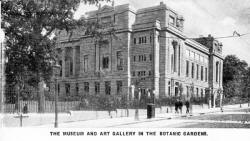 |
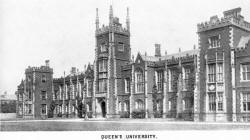 |
| THE
MUSEUM AND ART GALLERY |
QUEEN'S
UNIVERSITY |
Industry has
few industrial epics more thrilling than the story of the how, within
half a century or so, this insignificant little Queen's Island shop
bourgeoned into the world's best equipped shipbuilding yard, and the
cradle of great liners. From 23 the pay roll enlarged to normally 12,000
pre-war. What other firm in the universe built 78 ships, both sail and
steam, representing over 1,300,000 tonnage, for one ownership? Harland &
Wolff did so for the White Star Line. Concurrent also with the progress
of Harland & Wolff was the similarly striking expansion of Belfast's
second great shipbuilding plant�Workman, Clark & Co., Ltd. First an
offshoot in 1879, and now an amicable rival, it is equally famed for
quality and quantity output. Belfast never puts its eggs into one basket
; it has also tobacco, engineering, rope, mineral water, distilling,
biscuit, and a score other varied industries �all of individuality and
character. No empty boast is it, either, that Belfast is the home of
five of the world's largest industrial concerns. The greatest
shipbuilding plant is by the Lagan, side by side in York Street stand
the mammoth linen mills (York Street Spinning Co.), and tobacco factory
(Gallaher's). On the County Down side is the world's greatest ropeworks
; and when you couple with these the great Dunville distillery, you have
a quintette explaining why Belfast is on the world's map. What also of
the Ulster coat ? And a Belfastian, John B. Dunlop, by inventing the
pneumatic tyre, provided the basis for the motor car and therefrom
evolved the airplane. Hence Belfast revolutionised world transport.
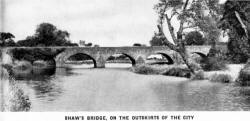 |
| SHAW'S BRIDGE ON
THE OUTSKIRTS OF THE CITY |
Belfast's progress during its maturity era�the 19th and early 20th
centuries�challenges consideration. 30,000 population in 1816 ; then
100,000 in 1851 ; and then 208,000 souls only thirty years later (1881).
The 20th century began with 349,180 and now Belfast's population is
probably over 480,000. Hence, during the past century the population
advance of Belfast has been almost twenty fold. The civic administration
of Belfast, like good wine, "needs no bush." Its civic amenities are
modern and ever progressive. Moreover, this amenities, wire" city is
remarkably free from slums ; its expansion has been so rapid that sites
in its central area are too valuable to remain cumbered by out-of-date
edifices. Excellently encouraging this exodus of dwellers to the healthy
suburbs also is the cheap tramcar fare of 2d. to all termini, even five
miles distant, as well as bus and train services to country and seaside.
liberally direct and regular, of the streets in the City Hall
vicinity�Donegall Square, Wellington Place, Chichester, May and Howard
Streets �and you may estimate the culture and vision of those later 18th
and early 19th century Belfastians, Pari passu the population
progressed. The 2,000 at the end of the 17th century (which had grown
from less than 500 at the end of the 16th century) multiplied to over
20,000 at the end of the 18th. Albeit, even then Belfast was, in
population, only fifth among Irish towns, Dublin, Cork, Waterford
and Limerick having more inhabitants and wealth. Belfast marked its majority in the 19th century ; it was only created a
city in 1888. What would be its gesture to the advent of industrialism ? Its industries
were domestic and handicrafts. Curiously, too,
although to-day Belfast is the world's Linenopolis, it
had only half a dozen linen looms in 1810. Cotton
ruled, with 860 looms clacking. Mass production would
inevitably extinguish manual. So with characteristic Belfast prescience
the Mulhollands re-equipped in 1830 their burnt-down Cotton Mill for
spinning flax by steam. The venture succeeded, and is to-day the great
York Street Linen Mills. Power weaving was more tardy, only coming to
Belfast in 1850. A decade later the unexpected erupted to speed-up
sluggishness. The American Civil War, beginning in 1861, interrupted the
world's cotton supplies. Le Roi est mort! Vive le Roi! Cotton was dead;
Linen was king, and Belfast boomed into bounteous prosperity. Even
to-day its linen leads the world, and the annual output of cloth here is
sufficient to cover almost threefold Belfast's city area of 25 square
miles.
 Concurrently another fortuity accelerated Belfast's accession to world
fame. Shipbuilding had been vicarious since 1636, and its small yard, a
patch of the mud of Queen's Island�itself an artificial product adopted
as a seaside pleasure resort�was moribund in 1858, when its proprietor,
Robert Hickson, engaged as assistant, Edward Harland, son of a
Scarborough doctor. Harland�then only in his early twenties�pluckily
acquired the unpromising plant. And so in 1860�augmented by Gustavus W.
Wolff, a genial German, began the Harland & Wolff firm. Industry has few industrial epics more thrilling than the story of the
how, within half a century or so, this insignificant little Queen's
Island shop bourgeoned into the world's best equipped shipbuilding yard,
and the cradle of great liners. From 23 the pay roll enlarged to
normally 12,000 pre-war. What other firm in the universe built 78 ships,
both sail and steam, representing over 1,300,000 tonnage, for one
ownership? Harland & Wolff did so for the White Star Line. Concurrent
also with the progress of Harland & Wolff was the similarly striking
expansion of Belfast's second great shipbuilding plant�Workman, Clark &
Co., Ltd. First an offshoot in 1879, and now an amicable rival, it is
equally famed for quality and quantity output. Belfast never puts its
eggs into one basket ; it has also tobacco, engineering, rope, mineral
water, distilling,
biscuit, and a score other varied industries �all of individuality and
character. No
empty boast is it, either, that Belfast is the home of five of the
world's largest industrial concerns. The greatest shipbuilding plant is
by the Lagan, side by side in York Street stand the mammoth linen mills
(York Street Spinning Co.), and tobacco factory (Gallaher's). On the
County Down side is the world's greatest ropeworks ; and when you couple
with these the great Dunville distillery, you have a
quintette explaining why Belfast is on the world's map. What also of the
Ulster coat ? And a Belfastian, John B. Dunlop, by inventing the
pneumatic tyre, provided the basis for the motor car and there from
evolved the airplane. Hence Belfast revolutionised world transport. Belfast's progress during its maturity era�the 19th and early 20th
centuries�challenges consideration. 30,000 population in 1816 ; then
100,000 in 1851 ; and then 208,000 souls only thirty years later (1881).
The 20th century began with 349,180 and now Belfast's population is
probably over 480,000. Hence, during the past century the population
advance of Belfast has been almost twenty fold. The civic administration
of Belfast, like good wine, "needs no bush." Its civic amenities are
modern and ever progressive. Moreover, this amenities, wire" city is
remarkably free from slums ;
its expansion has been so rapid that sites in its central area are too
valuable to remain cumbered by out-of-date edifices. Excellently
encouraging this exodus of dwellers to the healthy suburbs also is the
cheap tramcar fare of 2d. to all termini, even five miles distant, as
well as bus and train services to country and seaside. The
surroundings of Belfast are indeed beautiful beyond those of most
cities. High hills, heathered, wooded, and tilled, arise on every aspect
save where the river embouches eastward to meet the sea. From all the
big streets vistas of the circling hills give charm and chase away
monotony. Withal, material assets do not entirely enrich a people and he
who would really know about Belfast and its people must also take
cognisance of other factors�their high place in science, literature, art
and culture generally. If in the 18th century the intellectual
activities of Belfast supported its claim as " The Northern Athens," it
has now fully earned that title. Its University, Art Gallery, Museum,
College of Technology, Art Exhibitions and Musical Festivals, authors,
artists, dramatists, architects and scholars are indisputable evidences
of its eminence. In the conjoint realms of charity and curing, too,
what better indication of the liberality and attitude of a city may be
adduced than its public hospitals ? Certainly he who visits that square
mile in West Belfast in which are located its palatial Victoria,
Children's and Maternity Hospitals, all voluntarily supported, will
admit that in benevolence and love of their fellowmen Belfast people are
among the best of mankind. Difficult as it is to convey a conception
of Belfast's teeming interest to the visitor, some of its "high lights"
may be suggested. Thus, as start off, the visitor should ascend the City
Hall Dome (173 feet high), and view the delightfully comprehensive
panorama. It will be observe Belfast occupies a basin traversed by the
Lagan and encircled by ramparts of green hills. Surveyed from this
eminence, too, the city's lay-out is traceable ; Donegall Place,
dignified and broad, runs northerly to be continued into Royal Avenue
and then York Street. High Street�Belfast's oldest thoroughfare�goes
easterly from Castle Junction (the meeting of Donegall Place and Royal
Avenue) to end at the river.
 Immediately fronting the City Hall,
Donegall Square North and its continuation�Wellington Place�stretch
westward to terminate in the cheery red-bricked Royal Academical
Institution�the one-time Belfast College, and now a public school which
gave the world Viscount Bryce (who had 33 University degrees), Lord
Kelvin and others. Adjoining is the more modern Municipal College of
Technology. Eastward, Donegall Square North continues in Chichester
Street down to the river, and has as ending the Ulster Law Courts.
Other facets of interest are the linen district occupying Bedford Street
(the continuation of Donegall Square West), and the stately near-by
insurance buildings of Donegall Square and the far-distant greenery of
the Ormeau Park. And now a few minutes can be spared to visit the
Council Chamber, Banquet Hall and Great Hall�the latter having a 5-ton
Donegal woven carpet�as well the reposeful old-world courtyard. Emerging
from the City Hall, its architecture�a pleasing blend of 17th and 18th
century Renaissance so synonymous with Belfast's history�and especially
the allegorical group of the Central pediment call for some interest.
Boarding a "Malone" or "Stranmillis" tramcar the visitor soon alights at
Queen's University�more fittingly " Ulster University." In its
Examination Hall is a replica of Titian's "Assassination of Peter the
Martyr," now enormously enhanced in value by the loss of the original in
a fire at Venice in 1867. The visitor will also find much interest in
the various Natural History, Medical and Surgical Museums and the
Gallery of Classical Archeology, and especially in the placid
Quadrangle.
The Botanic Gardens Park, adjoining the University grounds, a
delightful area with charming vistas at every turn, includes
conservatories, lawns, rose walks and a splendid tropical garden where
it is possible to see figs and even banana trees bearing abundant fruit.
A fine statue of Lord Kelvin, the famous Belfast scientist, who
elucidated the laws of nature for men, adorns the entrance to this
beautiful park. Good pictures call for frames in harmony, and
Belfast's City Fathers acted wisely in selecting the Botanic Gardens to
contain the Municipal Art Gallery and Museum, which, although not yet
fully completed, will well repay visiting. The Museum, the foundation
stone of which was laid by H.R.H. the Duke of York in 1924, is unique in
its collection of Spinning Wheels and also early models of bicycles, as
well as its wonderful relics of the pre-Celtic world and of bygone
Ulster life. The McGowan collection of views of Old Belfast will
fascinate students of the city's history. The Art Gallerys prime feature
is the representative collection of pictures donated by Sir John Lavery,
R.A., to the city of his birth, as well as works by William Conor, James
Humbert Craig, F. McKelvey, J. W. Carey, W. R. Gordon, John A. Hunter,
and others of the Ulster school. It is indicative of Belfast's art
pretensions that the Art Gallery is to be extended. No visitor to
Belfast should miss this building, especially on Wednesday afternoons,
when an orchestral concert blends so admirably art and music. Leaving
the Art Gallery and Museum the visitor may stroll along the Stranmillis
Road past the new Lagan Boulevards to the first lock on the River Lagan,
and thence along the towpath is a delightful ramble with each turn
revealing a still more felicitous view. At Shaw's Bridge, the visitor
may regain the road, and returning cityward board the tramcar at Malone,
or walk on towards Drumbo to see the famous Giants Ring, an earthwork
built aeons before Belfast was even a village. At the tramway terminus
on the Lisburn Road are situated the beautiful Show Grounds of The Royal
Ulster Society, where will be seen the imposing Pavilion, opened on 29th
May, 1934, by H.R.H. the Duke of Gloucester, and named by the gracious
order of His Majesty the King, "The King's Hall."
Approached by the " Dundonald" car the Northern Ireland Parliament
Buildings, in the Greek Classical tradition, constitute a majestic
edifice, occupying the centre of Stormont Park, which also holds
Stormont Castle, the official residence of the Premier, together with
the Lodge wherein the Speaker resides. The Parliament Buildings comprise
the two legislative halls, together with 147 rooms devoted to various
administrative departments. An imposing statue of Lord Carson is
prominent in front of the pile. A few paces beyond the Parliament
Buildings and the tram terminus at Dundonald is the apex of the 13
miles' triangle of roads constituting the world famous Inter-national
Tourist Trophy motor race held every September. Returning to the city,
the visitor travels through Ballymacarrett, Belfast's great transpontine
industrial suburb, largely occupied by workers in the shipyards,
ropeworks and other industries. The view down the river from the Queen's
Bridge gives a glimpse of the importance of Belfast's daily commerce
with England and Scotland. However, to deduce how similarly great is the
overseas commerce and also to visit the shipyards, the visitor should
take a car to the York Street railway terminus and proceed to the river,
and then across by ferryboat to the County Down side. Some other
noteworthy places of interest are St. Anne's (Belfast) Cathedral in
Donegall Street, the new Law Courts in Lower Chichester Street, and the
Linen Research Institute at Lambeg (reached by bus). The pilgrim to
Belfast can not reckon his visit complete unless he includes Belfast
Castle demesne (donated by Lord Shaftesbury), and the connected pleasure
grounds of Bellevue and Hazelwood on the Antrim Road, reached by tram
and bus from Castle Junction. Few cities are blessed with a more
charming pleasure region than this shelf with its desirable and
extensive views of land and sea. It represents the happy combination of
nature and art at their best, while the Hazelwood portion simulates a
miniature Switzerland. Visitors are recommended to ascend from Bellevue
through the rustic glen to reach the lofty Cave Hill and McArt's Fort
(1,100 feet) from which the view is surpassing fine. Indeed, from a
little behind the Fort and rather more northerly it is possible to scan
four loughs �Belfast, Strangford in County Down, Larne (a peep), and
Neagh (the largest United Kingdom lake). If not pressed by time the
visitor may stroll citywards over the hills and descend to board the bus
on the Cavehill Road. A reference to a few of Belfast's citizens who
have enriched the world with their learning and art, and brought honour
to their city, who have not been referred to already in these pages,
would not be out of place. Amongst these are Sir William MacCormac, Sir
Donard Currie, and Sir Almroth Wright. In the 18th century there was Dr.
William Drennan, in whose poems the description of Ireland as "the
Emerald Isle first found birth, and in the 19th century Sir Samuel
Ferguson, a poet of real distinction. Of our own generation, Mr. Forrest
Reid is a novelist with a very subtle and sensitive genius, and Mr.
Richard Rowley's poetry, beautiful in itself, has carried beauty into
the grime and stress of workaday life. Mr. Robert Lynd, a truly
delightful essayist, comes from Belfast, as does Mr. Douglas, editor of
the " Sunday Express " ; Mr. St. John Ervine, the famous author,
dramatist and dramatic critic, Mr. George A. Birmingham, Miss Helen
Waddell and Dr. W. J. Lawrence, the Shakespearian authority. To the
stage Belfast has contributed of recent years Mr. J. B. Fagan, author of
the happy And so to Bed" ; Mr. John Rea, of "Abraham Lincoln" fame ; and
three clever women�Miss Cathleen Nesbit, Miss Moyna MacGill, and Miss
Helen Gilliland.

County Antrim.
BY ALEXANDER RIDDELL.
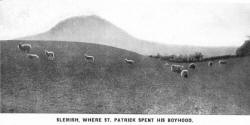
" So to the land our hearts we give,
Till the sure magic strike,
And Memory, Use, and Love make live
Us and our fields alike --
That deeper than our speech and
thought,
Beyond our reason's sway,
Clay of the pit whence we were wrought
Yearns to its fellow clay.''�KIPLING. AND if we in County Antrim
think of our fields or moors, our towns, our villages, whichever be our
home, much as Dr. Boteler looked upon the strawberry : " Doubtless God
could have made a better berry, but doubtless God never did " out of the
depths, the very fundamentals of existence, comes the cause, as phrased
by Kipling : "Clay of the pit whence we were wrought
Yearns to its fellow clay." There are, to be sure, externals�proud
memories, prouder, it may be, than those of any other county in Ireland.
Almost in the centre of the county stands Slemish, the mountain on whose
slopes the captive Patrick herded Milchu's pigs, and where he made his
first convert�himself. " Now after I came to Ireland "�the words are
Patrick's own�"daily I herded flocks and often during the day I prayed.
Love of God and His fear increased more and more, and my faith grew and
my spirit was stirred up so that in a single day I said as many as a
hundred prayers, and at night likewise, though 1 abode in the woods and
in the mountain." In Antrim, too, was the Kingdom of Dalriada, one of
whose rulers, Fergus MacErc, crossed the narrow channel to what was then
Alba and founded another kingdom, gradually extended by his descendants,
till they gave the whole country a single name, Scotland, and that
single and central monarchy by which it was saved many of the evils
which rend Ireland till this day. These are, indeed, proud memories,
but there are others. There is history, at times vehement and bloody,
beyond the memory of man ; and there is romance, which, after all, is
history though told rather by the heart than by the head, in which what
matters is not the date, or the cause, or the consequence, but the vivid
and poignant emotions and personalities of the moment. These are the
things the traveller, the visitor, the passer-by can gather, the wise
traveller becoming thereof a harvester rather than a gleaner, and no
matter how great the bounty he may seek County Antrim can offer and
supply it�and more. And with that let us move on. Belfast is
described elsewhere, and we are now moving out of it between the hills
on the left and the sea on the right, for the long coast run. It is
worth while glancing towards the Cave Hill to see the outlines of
Napoleon's face, which can only date from his deathbed in St. Helena,
yet nobody has ever been able to tell me whose name it bore before the
days of the Corsican ogre ; and it is worth while glancing at the beach
and recalling the old Quaker who, having left his hat at home that he
might not have to take it off to Royalty, somewhere on the shore not far
from the town met King William III. with the sedate but sincere
greeting, " Friend, thee art welcome here."

Carrickfergus
The first place of importance is Carrickfergus. (the Rock of
Fergus), the Fergus mentioned above. " Lustie he was,
and large of lym and lith,
His forme, his figure and his countenance
Than thought that tyme rycht gudlie to advance."
He it was who took to Scotland the Lia Fail, or Stone of Destiny,
fabled to be Jacob's pillow, which lay in his castle of Dunstaffnage
till a later generation removed to Scone, whence King Edward, the "
Hammer of the Scots," removed it to Westminster Abbey. A not
uninfluential school of Irish Archaeologists, however insist that the
veritable Lia Fail never left Ireland, and that in " Tara of the Kings"
it still remains. When Fergus had been on his Scottish throne for
twenty-five years he returned to Ireland�some say to arbitrate in a
dispute, others that, afflicted with a skin disease I came to drink of a
water in a medicinal well. Be that it may the galley that bore him was
wrecked at or near this rock, and hence the name. " In
all that schip eschapt nor aid nor young
But perreist all with guid
Fergus their king ;
Efter his name, my stone tellis thus,
That place sensyne is
callit Craigfergus."
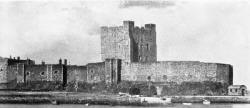 Six
centuries after the time of Fergus, the Angle Normans swept across the
land, and Carrickfergus Castle, the castle we see now, was built either
by De Courcy, the first Norman to invade Ulster and conquer of its
littoral from Downpatrick to Derry, or by his successor, De Lacy. Here
during his visitation of Ireland rested for a while King John, by whom
the district round the castle was made a county, the rent to the Crown,
according to charter being "the rising of one mann, with a bow without a
string and an arrow without a feather." Here for a space dwelt two kings
together Robert and Edward Bruce, though Edward, to be sure was never
more than titular King of Ireland, his kingdom resembling that chateau
in Spain which is first cousin to the castle in the air. Its walls also
welcomed William III., before he journeyed on to Belfast. It has stood
sieges, one by the Bruces, when the garrison was ultimately starved into
surrender, having first, says tradition, or legend (not synonymous
terms) devoured thirty Scottish prisoners. It suffered siege in
Cromwellian days, and later by Schomberg ; later still by Thurot, Irish
by descent, a smuggler, sometime gamekeeper to the Earl of Antrim, and
at the time of his invasion an officer in the Royal French Navy. Again
the Castle, which then was in a ruinous condition, had to surrender, but
not until the small garrison, a few recruits of the 62nd Foot, now the
Wiltshire Regiment, had fired away all their ammunition, had fired away
also their buttons, and then taken to throwing stones. A piece of plate
was later presented to their C.O., a Captain Jennings. Where it is now
who can say, but the regiment still wears a splash or dent upon its
buttons in memory of the defence. Thurot made a hasty levy of provisions
and money and sailed away, to be caught and brought to battle three days
later by Captain Elliott, off the Isle of Man, when he himself was
killed and his little fleet captured. A pleasing and true story of the
fight at Carrick records that one of the French, seeing an infant
straying on to the street, dropped his firelock and carried the child to
a place of safety. Curiously, as good an account as any of the whole
transaction is told by John Wesley, who visited the town shortly
afterwards, and for a man of peace was surprisingly interested in the
field of war. Six
centuries after the time of Fergus, the Angle Normans swept across the
land, and Carrickfergus Castle, the castle we see now, was built either
by De Courcy, the first Norman to invade Ulster and conquer of its
littoral from Downpatrick to Derry, or by his successor, De Lacy. Here
during his visitation of Ireland rested for a while King John, by whom
the district round the castle was made a county, the rent to the Crown,
according to charter being "the rising of one mann, with a bow without a
string and an arrow without a feather." Here for a space dwelt two kings
together Robert and Edward Bruce, though Edward, to be sure was never
more than titular King of Ireland, his kingdom resembling that chateau
in Spain which is first cousin to the castle in the air. Its walls also
welcomed William III., before he journeyed on to Belfast. It has stood
sieges, one by the Bruces, when the garrison was ultimately starved into
surrender, having first, says tradition, or legend (not synonymous
terms) devoured thirty Scottish prisoners. It suffered siege in
Cromwellian days, and later by Schomberg ; later still by Thurot, Irish
by descent, a smuggler, sometime gamekeeper to the Earl of Antrim, and
at the time of his invasion an officer in the Royal French Navy. Again
the Castle, which then was in a ruinous condition, had to surrender, but
not until the small garrison, a few recruits of the 62nd Foot, now the
Wiltshire Regiment, had fired away all their ammunition, had fired away
also their buttons, and then taken to throwing stones. A piece of plate
was later presented to their C.O., a Captain Jennings. Where it is now
who can say, but the regiment still wears a splash or dent upon its
buttons in memory of the defence. Thurot made a hasty levy of provisions
and money and sailed away, to be caught and brought to battle three days
later by Captain Elliott, off the Isle of Man, when he himself was
killed and his little fleet captured. A pleasing and true story of the
fight at Carrick records that one of the French, seeing an infant
straying on to the street, dropped his firelock and carried the child to
a place of safety. Curiously, as good an account as any of the whole
transaction is told by John Wesley, who visited the town shortly
afterwards, and for a man of peace was surprisingly interested in the
field of war. Another notable building in Carrickfergus is the Parish
Church, dedicated, as it should be in a seafaring town, to St. Nicholas,
patron saint of sailors. Its chief monument is to Sir Arthur Chichester,
founder of Belfast. Beneath it is a small figure of his brother, Sir
John, whose head was struck off in a battle with the Macdonnells. Years
later James Macdonnell, according to a foolish story, protested against
the figure being any-thing but headless. " How cam he to get his held,
for sure I am I ance took it frae him "�and the inventors of the story
forgot that Macdonnell was purely a Gaelic speaker to whom Lowland Scots
was as alien as Greek. In Carrick, readers may be interested to hear,
was held the first regularly constituted Presbytery in Ireland, attended
by five ministers and four ruling elders, for the four sessions already
erected. It met on the 10th June, 1642, and two centuries later the
event was sung by William McComb, Presbyterianism's poet laureate :
" Two hundred years ago there came from
Scotland's storied land
To Carrick's old and
fortress town a Presbyterian band ;
They planted
on the Castle wall the banner of the Blue,
And
worshipped God, in simple form, as Presbyterians
do."
The pleasure amenities of the town include a golf course, public lawn
tennis courts, boating, bathing and fishing.

Kilroot and Swift.
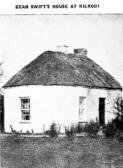 Not
far from Carrick is Kilroot, where Thurot's force landed ; but more
famous for the fact that it was here Swift lived during his brief
clerico-official stay in the north. His garden is still to be seen ; so
also is what is claimed locally to be his cottage, thatched and of a
curious oval shape ; so also are the ruins of his church. An
Episcopalian in a Presbyterian district, his congregations were small;
and the story is told that he spent part of one Sunday carrying stones
into the church. Curious to see what he was doing, a number of people
followed him, and, having got them inside, Swift locked the doors and
conducted a service. Tradition also preserves an account of his fondness
of skimming stones along the surface of the Lough. It was during his
residence in the north that Swift had that love affair with Jane Waring,
which expired in perhaps the strangest of all the world's love letters.
Of the Warings nothing is left in Belfast except the name perpetuated in
one of its streets�called after Jane's father and brother, and before
that�eloquent of the narrow streets of the little town�known as Broad
Street. Not
far from Carrick is Kilroot, where Thurot's force landed ; but more
famous for the fact that it was here Swift lived during his brief
clerico-official stay in the north. His garden is still to be seen ; so
also is what is claimed locally to be his cottage, thatched and of a
curious oval shape ; so also are the ruins of his church. An
Episcopalian in a Presbyterian district, his congregations were small;
and the story is told that he spent part of one Sunday carrying stones
into the church. Curious to see what he was doing, a number of people
followed him, and, having got them inside, Swift locked the doors and
conducted a service. Tradition also preserves an account of his fondness
of skimming stones along the surface of the Lough. It was during his
residence in the north that Swift had that love affair with Jane Waring,
which expired in perhaps the strangest of all the world's love letters.
Of the Warings nothing is left in Belfast except the name perpetuated in
one of its streets�called after Jane's father and brother, and before
that�eloquent of the narrow streets of the little town�known as Broad
Street. Whitehead and Islandmagee
"Allays a-moving on," like Poor Jo, one comes next to Whitehead, a
pleasant town by the edge of Belfast Lough. How rapidly it has grown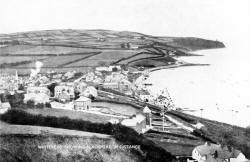 from hamletry may be gauged from the fact that not so many years ago its
station was an old railway carriage. In its development it echoes
Addison :
from hamletry may be gauged from the fact that not so many years ago its
station was an old railway carriage. In its development it echoes
Addison : " 'Tis not in mortals to command success,
But we'll do more, Sempronius, we'll deserve it." Once named Castle
Chichester, it is the centre of a district rich in historical
associations. The ruins of the old castle, built by a Sir Moyses Hill in
Elizabethan days, still stand, and the story is told how within its
rooms Sir Moyses was once neatly hoist with his own petard. Wishing to
get the better in a piece of business with the Governor, Sir Moyses
invited him to supper, and ordered the butler to serve the guest with
wine and Sir Moyses himself with coloured water. The butler reversed the
order, with the result that at the end of the evening the Governor very
drily thanked Sir Moyses more for his meat than for his drink," while
the latter was scarcely able to move from his seat. "What have you to
say, Sirrah," he demanded of the butler next morning, "Why I should not
hang thee ?" The butler's reply was that he did not see why the man who
paid for the good wine should drink water, while he who paid nothing
drank of the best�which proved to be another of the soft answers which
turn away wrath. As behoves a place which is partly residential and
partly a seaside resort, Whitehead caters well for health and for
amusement It is the headquarters of the County Antrim Yacht Club, which
in addition to the weekly sailing events, runs an Annual Regatta.
Excellent sea bathing can be had, and the Council has provided a
swimming pond which renders the bather independent of the tides. Sea
fishing can, of course, be practised alike by boat and from the rocky
coast. The town offers golf (a nine-hole course) and tennis, both
available for visitors. It is a fine centre for the walker, who should
not omit a visit to Blackhead with its caves and cliff path. There are
numerous places still possessing historical interest�such as
Muldersleigh, which contains an ancient entrenchment and was at one time
a "hosting" or gathering place, for the name means "bare height of the
host," and Slaughterford Bridge, reminiscent of "old, unhappy, far-off
things, and battles long ago." In the neighbourhood also is Aldfreck,
where James Macdonnell defeated Sir John Chichester, and not far away is
Ballycarry, through which access is gained to the peninsula of
Islandmagee. Ballycarry is notable for more than that, for if the first
Presbytery met in Carrick, the first Presbyterian services in Ireland
were held in this little village, as sung by James Orr, the " Bard of
Ballycarry." "There thy revered forefathers heard,
The first dissentors dared to tarry,
On Erin's plain, where men felt pain
For conscience sake in Ballycarry." Orr died over a century ago, and
his tomb, erected by Brother Freemasons, may still be seen. He shared in
the "Turn-out," i.e., the rebellion, of 1798; took part in the Battle of
Antrim, and later fled to America. He returned under an amnesty, and
more fortunate than a namesake, lived the remainder of his life
untroubled. Islandmagee itself is worth exploring. Its most tragic
memory is connected with the Wars of 1641, when some of the
inhabitants�one says "some," because the number varies in different
accounts from 30 to 3,000�were driven over the cliffs into the sea by
the Scottish garrison of Carrickfergus. The shocking deed is
commemorated, it is said, in the name of Slaughterford Bridge. One of
the very few Irish trials for witchcraft�few things in Irish history are
more extraordinary than the country's almost complete freedom from the
witch mania which devastated Europe in the 17th century�had its origin
in Islandmagee in 1711, when eight unfortunate women were solemnly tried
by two judges (who disagreed), found guilty, and awarded imprisonment
and the pillory.

Gobbins
 One
of the most striking walks in the country is that round the foot of the
precipitous cliffs known as the Gobbins, made possibly by vision and
genius of a railway engineer, who bridged and tunneled and cut a path
which runs for over a mile. The Druid's Altar and the Rocking Stone are
other objects of interest. One
of the most striking walks in the country is that round the foot of the
precipitous cliffs known as the Gobbins, made possibly by vision and
genius of a railway engineer, who bridged and tunneled and cut a path
which runs for over a mile. The Druid's Altar and the Rocking Stone are
other objects of interest. Islandmagee, however, is a diversion from
the main road, which runs on the mainland side of the Lough and passes
through Magheramorne. Now chiefly important as a tiny harbour exporting
limestone, it was the birthplace of St. Comgall, founder of the famous
Abbey in Bangor, in the County Down, from which, according to tradition,
in later centuries King Alfred sought teachers and leaders. The hamlet
has given a title to the peerage, Baron Magheramorne, and the story has
been published that an English butler, unable to pronounce the, to him,
extraordinary gutterals, at one important reception, announced the first
holder as the late Sir James McGarel Hogg." Larne.
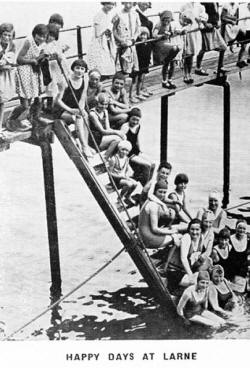 So
one passes to Larne. Here at the Corran, at the head of 300 ships and
6,000 men, landed Edward Bruce in that disastrous attempt to make
himself King of Ireland�three years of war, pestilence and famine, when
the people, it is said, became cannibals and even dug the dead out of
their graves, while the Scots were reduced to eating their own horses.
Bruce was at last crowned near Dundalk, but his was, like Macbeth's, a
barren victory and, like Duncan's murderer, he fell in battle and
entered a bloody grave. So
one passes to Larne. Here at the Corran, at the head of 300 ships and
6,000 men, landed Edward Bruce in that disastrous attempt to make
himself King of Ireland�three years of war, pestilence and famine, when
the people, it is said, became cannibals and even dug the dead out of
their graves, while the Scots were reduced to eating their own horses.
Bruce was at last crowned near Dundalk, but his was, like Macbeth's, a
barren victory and, like Duncan's murderer, he fell in battle and
entered a bloody grave. It was somewhere off the entrance to Larne
Lough that there was found in the shape of a salmon Liban, the daughter
of Ecca, in whose time Lough Neagh burst forth. All were drowned except
Liban, who lived as a salmon for three hundred years. At the end of that
time Beoc, a monk under the St. Comgall already mentioned, was sailing
across the waters when he heard chanting beneath his vessel. Liban
raised her face above the surface. " I am Liban," she said, and I
beseech thee to come to Inver Ollarba (the mouth of the Larne Water) a
year hence from to-day. Say to Comgall, and to the other holy men of
Bangor, all that I say to thee. Come with thy boats and thy fishing
nets, and thou shalt take me from the waters in which I have lived so
long." And a year hence she was taken in a net, given the choice to die
immediately and go to heaven, or live as long as she had lived in the
sea and then go to heaven. She preferred to die immediately, so Comgall
baptised her as Murgen, or the " Sea-Born, and so she died.
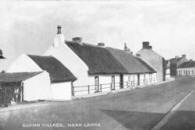 Lough
Neagh borders a large part of Antrim, and though there will be reason to
mention it again when this brief narrative refers to the town of Antrim,
the rest of the legend may as well be told now. Ecca was the son of a
King of Munster, and for some reason had to flee north. To help him in
his journey he was given a great horse, but warned never to allow it to
stand still. Ater long travel Ecca reached the Plain of the Grey Copse,
and here he determined to settle. But he allowed the horse to stand and
immediately a spring burst out beneath its feet. Upon it Ecca built a
door, over which he placed a woman whose sole duty it was to keep it
shut. Curnan the Simpleton foresaw disaster : Lough
Neagh borders a large part of Antrim, and though there will be reason to
mention it again when this brief narrative refers to the town of Antrim,
the rest of the legend may as well be told now. Ecca was the son of a
King of Munster, and for some reason had to flee north. To help him in
his journey he was given a great horse, but warned never to allow it to
stand still. Ater long travel Ecca reached the Plain of the Grey Copse,
and here he determined to settle. But he allowed the horse to stand and
immediately a spring burst out beneath its feet. Upon it Ecca built a
door, over which he placed a woman whose sole duty it was to keep it
shut. Curnan the Simpleton foresaw disaster : " Come
forth, come forth, ye valiant men, build boats and build ye fast !
I see the waters surging out, a torrent deep and vast ;
I see our chief and all his host o'erwhelmed beneath the wave,
And Arin, too, my best beloved, alas, I cannot save."
But nobody listened, there was no Noah, and when at last the woman
forgot to close the well door, the flood rushed out �and all, except
Liban, were drowned. And thus the Plain of the Grey Copse is now Lough
Neagh, the largest lake in the British Islands.
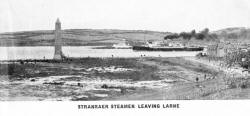 Larne,
it need scarcely be said, has the distinction of being the Irish
terminus, as Stranraer is the Scottish, of the shortest sea passage
between this island and Great Britain �a privilege once held by
Donaghadee and Portpatrick. Larne owes many of its amenities to the love
borne for the place by the late Mr. Chaine, whose body, buried upright
in the cliffs, looks eternally over the waters he knew so well. A modern
Round Tower, 92 feet high, to his honoured memory, was erected by public
subscriptions. Larne,
it need scarcely be said, has the distinction of being the Irish
terminus, as Stranraer is the Scottish, of the shortest sea passage
between this island and Great Britain �a privilege once held by
Donaghadee and Portpatrick. Larne owes many of its amenities to the love
borne for the place by the late Mr. Chaine, whose body, buried upright
in the cliffs, looks eternally over the waters he knew so well. A modern
Round Tower, 92 feet high, to his honoured memory, was erected by public
subscriptions. The visitor must walk down to the Curran, a
sickle-shaped beach, hence the name, which in English is the
"reaping-hook," on which the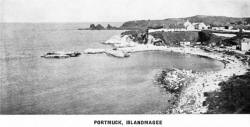 plundering Norsemen drove their galleys, and here he may wonder how
Ulfrek's Fiord, the Norse name of the Lough, became changed into
Wolverflete and Olderfleet, the name eventually given to a castle which
was later built here by the English. In another direction are the
Sallagh Braes, also a pleasant walk ; and in yet another a visit should
be paid to the villages of Glynn and Glenoe. The former is proud of the
ruins of a church said to have been founded by St. Patrick, and the
latter of its glen and waterfall and four cascades. A hint may be given
to the botanist to search for the Irish polypody.
plundering Norsemen drove their galleys, and here he may wonder how
Ulfrek's Fiord, the Norse name of the Lough, became changed into
Wolverflete and Olderfleet, the name eventually given to a castle which
was later built here by the English. In another direction are the
Sallagh Braes, also a pleasant walk ; and in yet another a visit should
be paid to the villages of Glynn and Glenoe. The former is proud of the
ruins of a church said to have been founded by St. Patrick, and the
latter of its glen and waterfall and four cascades. A hint may be given
to the botanist to search for the Irish polypody.
The town is a great tourist centre, and is well deserving of its
popularity, for in addition to being a most central spot for
'exploration of the Northern counties, Larne has in itself many
resources and amusements. There are excellent bathing, boating and
fishing ; there are tennis courts and a golf links ; while "just over
the way," as Dick Swiveller would say, in Islandmagee, is another golf
course.

The Coast Road
 It
is from Larne, running westward, that there starts the Coast Road
proper, of which it has been said that " had the engineer worked
with a poet and a painter at his back he could not have laid out his
course more agreeably to the eye and imagination." Turning and soaring
and dipping, like a swallow in its flight, with the sea on one hand and
the cliffs on the other, white masses of limestone, dark masses of
basalt ; with glens running into the country and streams tumbling down
to the sea, the road for the whole of its course has a beauty which
needs no adjectives. Its country, more-over, is haunted with stories,
from the dim past of legend till to-day. This was the land over which
struggled Macdonnells, O'Neills, and O'Cahans, whose castles, once the
homes of passion and emotion, are now voiceless ruins. It
is from Larne, running westward, that there starts the Coast Road
proper, of which it has been said that " had the engineer worked
with a poet and a painter at his back he could not have laid out his
course more agreeably to the eye and imagination." Turning and soaring
and dipping, like a swallow in its flight, with the sea on one hand and
the cliffs on the other, white masses of limestone, dark masses of
basalt ; with glens running into the country and streams tumbling down
to the sea, the road for the whole of its course has a beauty which
needs no adjectives. Its country, more-over, is haunted with stories,
from the dim past of legend till to-day. This was the land over which
struggled Macdonnells, O'Neills, and O'Cahans, whose castles, once the
homes of passion and emotion, are now voiceless ruins. "Around the
warrior's hearth and through the long
Coarse narrow-bladed grass that wraps his halls
like tell-tale life-stains of the past, arise
The lonely sea-pink's wiry-tufted flowers." The O'Cahans have
vanished, territorially, from the district, so have the O'Neills, but
the Macdonnells remain, their head, the Earl of Antrim, having his
family seat at Glenarm. Here in the days of Elizabeth was buried the
great Shane O'Neill, who had been stabbed to death by the skeans of the
Macdonnells. A local tradition states that soon after his burial there a
friar from Armagh arrived. " Father," he said to the Abbot at Glenarm, "
I come from our brothers of Armagh to beg that you will permit us to
remove the body of the great O'Neill for the purpose of interment in the
tomb of his ancestors at Armagh." The Abbot paused for a moment. " Have
you," he asked, "brought with you the remains of James Macdonnell, Lord
of Antrim and Cantire, who was buried among strangers at Armagh ?" The
Friar replied that he had not. " Then," declared the Abbot, "whilst you
continue to tread on the grave of James, Lord of Antrim and Cantire,
know ye that we here in Glenarm will trample on the dust of the great
O'Neill." When one adds that this James Macdonnell had been starved to
death in O'Neill's dungeon, and that O'Neill's head, "sund'red from his
bodie, was carried into the citie of Dublin, where it was bodied on a
stake and standeth on the top of your majestie's castle," some vision
will have been conveyed of the savagery of the times. Still the road
runs on�past Carnlough, past Garron Tower, near which is Dunmaul whence
it is said the last of the Danes sailed when leaving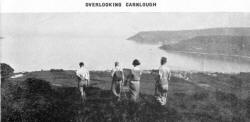 Ireland, past a curiously pinnacled rock in the sea, "Clough-i-Stookan,
which, it is said again (useful and non-committal phrase), was the
northern point from which the country used to be measured to Mizen Head
in the south. So the road twines round to Red Bay and Cushendall and
Cushendun, in which space of country are the " Nine Glens of Antrim."
Glens they are, but the name is more correctly " Glynnes," i.e., wooded
places. Here too are hills with names that sing like verse�Lurigethan,
and Trostan, and Tieve Bulliagh, and Slieve-an-Aura and Knocklayde. On
Lurigethan is said to have been the home of Ossian, his grave in
Lubitavish being marked by a stone circle, and on Slieve-an-Aura was
fought another of the innumerable battles, this time between the
Macdonnells and McQuillans. Near the viaduct at Glendun is a relic of a
different kind, a stone altar where the people used to meet for worship
in the penal days. The glens themselves, as has been said, are nine�Glenarm,
Glencloy, Glenariff, Glenballyemon, Glenaan, Glencorp, Glendun,
Glenshesk, and Glentaise�of which Glenariff is the most beautiful.
Ireland, past a curiously pinnacled rock in the sea, "Clough-i-Stookan,
which, it is said again (useful and non-committal phrase), was the
northern point from which the country used to be measured to Mizen Head
in the south. So the road twines round to Red Bay and Cushendall and
Cushendun, in which space of country are the " Nine Glens of Antrim."
Glens they are, but the name is more correctly " Glynnes," i.e., wooded
places. Here too are hills with names that sing like verse�Lurigethan,
and Trostan, and Tieve Bulliagh, and Slieve-an-Aura and Knocklayde. On
Lurigethan is said to have been the home of Ossian, his grave in
Lubitavish being marked by a stone circle, and on Slieve-an-Aura was
fought another of the innumerable battles, this time between the
Macdonnells and McQuillans. Near the viaduct at Glendun is a relic of a
different kind, a stone altar where the people used to meet for worship
in the penal days. The glens themselves, as has been said, are nine�Glenarm,
Glencloy, Glenariff, Glenballyemon, Glenaan, Glencorp, Glendun,
Glenshesk, and Glentaise�of which Glenariff is the most beautiful. For
the non-Gaelic visitor the names may be translated with the proviso that
Gaelic scholars evidently do not agree. Glenarm, then, means " Glen of
the Army" ; Glencloy, " Glen of the Sword," or " Glen of the Dykes" ;
Glenariff, the "Arable Glen" ; Glenballyemon, " Edwardstown Glen" ;
Glenaan, " Glen of the Proverb," or " Hemmed-in Glen" ; Glencorp or
Glencorb, " Glen of the Dead Body," or " Glen of the Coaches" ; Glendun,
the " Brown Glen " ; Glenshesk, the "Sedgy glen " ; and Glentaise, "
Glen of Taise Taobhgeal "�Taise being a daughter of a King of Rathlin,
and of how she was sought as a wife by the King of Norway, of his
invasion of Rathlin, and of the battles that followed till he was
killed, a long, long story is told. " It is better than the enjoyment of
a feast how we have fought the great battle," said Taise when it was all
over.

Carnlough, Cushendun & Cushendall
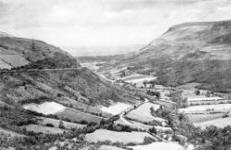 There
are few pleasanter places than Carnlough, Cushendun or Cushendall
for the seeker of a quiet holiday, especially to those still given to
the use of their legs, with the glens to explore and lofty hills to
climb. Glenariff, as has been suggested, is the most scenic. Art has
here been added to nature, paths have been cut and bridges erected to
allow the visitor easier access to this " Switzerland in miniature," as
Thackeray called it. There are several waterfalls, the upper and higher
being Ess-na-Larach, the " Fall of the Mares," the lower being
Essna-Crub, " Fall of the ' Hoof," though why the names, what mares and
hoofs are thus perpetuated. one does not know. But Glenariff is only
one. All are worth exploring, and what has been said of one of the lofty
hills can be said of the whole district There
are few pleasanter places than Carnlough, Cushendun or Cushendall
for the seeker of a quiet holiday, especially to those still given to
the use of their legs, with the glens to explore and lofty hills to
climb. Glenariff, as has been suggested, is the most scenic. Art has
here been added to nature, paths have been cut and bridges erected to
allow the visitor easier access to this " Switzerland in miniature," as
Thackeray called it. There are several waterfalls, the upper and higher
being Ess-na-Larach, the " Fall of the Mares," the lower being
Essna-Crub, " Fall of the ' Hoof," though why the names, what mares and
hoofs are thus perpetuated. one does not know. But Glenariff is only
one. All are worth exploring, and what has been said of one of the lofty
hills can be said of the whole district " People rave
of the scenery out in the west,
And they say of all lands 'tis the fairest and best,
But they don't know the talent Dame Nature displayed
When she last touched her canvas and painted Knocklayde.
The flowers of the tropics are fair to behold,
Where the orange tree nurses her globules of gold ;
Still it seems to my mind they don't `aquil' the shade
Of the blossom-clad whins on the side of Knocklayde."
And the visitor, especially if he takes any
interest in the stories and traditions of a district steeped in history
and romance, may be assured, in the words of another local poet, that
" Tho' lowly the cabins that dot this fair island,
Nor princely their tables nor sumptuous their fare,
Yet still for the wanderer by moor, vale or highland
There's a chair and a ` cead mille failthe ' found there." Passing
Cushendall and Cushendun, it may be noted that the latter was once the
home of Miss Moira O'Neill, who has sung of the district in verse that
attains to poetry. Here the road turns inland from the sea, but over
ground which to the lover of moorland is as beautiful, and past the
fairy lake, Loughareema, whose waters at times vanish. Miss O'Neill has
so written of it : Loughareema ! Loughareema !
Lies so high among the heather ;
A little lough, a dark lough,
The wather's black and deep.
Ould herons go a-fishing there,
And seagulls all together
Float round the one green island
On the fairy Lough asleep. Loughareema ! Loughareema !
Stars come out, an' stars are hidin' ;
The wather whispers on the stones,
The flittherin' moths are free.
One'st before the mornin' light
The horsemen will come ridin'
Roun' an' roun' the fairy lough,
An' no one there to see."
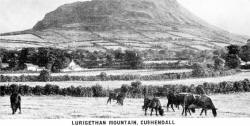 It
can be a dangerous lough, and not so very many years ago Colonel
MacNeill and his coachman were drowned when, the lake being in flood,
their carriage went off the road in the darkness. It is a long climb to
the top of the moor and a long descent into Ballycastle. It
can be a dangerous lough, and not so very many years ago Colonel
MacNeill and his coachman were drowned when, the lake being in flood,
their carriage went off the road in the darkness. It is a long climb to
the top of the moor and a long descent into Ballycastle. There is
another route from Cushendun to Ballycastle, following the coast by a
road less skilfully engineered, however, than the coast road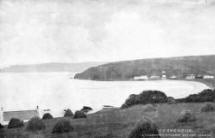 followed so far. It is, nevertheless, well worth taking for the sake of
Loughan and Portaleen Bays and Torr Head, and, above all, a diversion on
foot to Murlough Bay, and the Grey Man's Path, a slippery and steep but
possible path to the beach. A little further on is Fair Head, on whose
summit are two small lakes, Lough Dhu (" Black Lake "), and Lough-na-Crannoge
(" Lake of the Island "), a crannoge being a small artificial island,
found not only in Ireland, but also on the Continent, and eloquent of
days when it was necessary to seek every means of safety and protection.
From Fair Head it is easy to reach Ballycastle, either by returning
inland or scrambling down to the Coast Road, which reaches the foot of
the headland.
followed so far. It is, nevertheless, well worth taking for the sake of
Loughan and Portaleen Bays and Torr Head, and, above all, a diversion on
foot to Murlough Bay, and the Grey Man's Path, a slippery and steep but
possible path to the beach. A little further on is Fair Head, on whose
summit are two small lakes, Lough Dhu (" Black Lake "), and Lough-na-Crannoge
(" Lake of the Island "), a crannoge being a small artificial island,
found not only in Ireland, but also on the Continent, and eloquent of
days when it was necessary to seek every means of safety and protection.
From Fair Head it is easy to reach Ballycastle, either by returning
inland or scrambling down to the Coast Road, which reaches the foot of
the headland.

Ballycastle
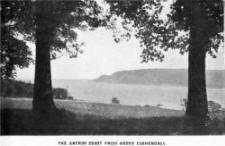 Is
connected with two of the most beautiful stories in Irish literature�the
one, that of the fate of the children of Lir, being pure fantasy, but
the other, concerned with Deirdre and the children of Usneach being most
probably true in its essentials. On the beach are to this day the rocks,
Carrig-Usneach, on which the latter landed coming from Scotland to
betrayal and death.]] Is
connected with two of the most beautiful stories in Irish literature�the
one, that of the fate of the children of Lir, being pure fantasy, but
the other, concerned with Deirdre and the children of Usneach being most
probably true in its essentials. On the beach are to this day the rocks,
Carrig-Usneach, on which the latter landed coming from Scotland to
betrayal and death.]] The children of Lir were the victims of a
stepmother who, jealous of their father's love for them, turned them
into swans doomed to live nine hundred years till released from the
enchantment by the sound of a Christian bell. Three hundred of these
they spent on the stormy waters opposite Ballycastle, the only girl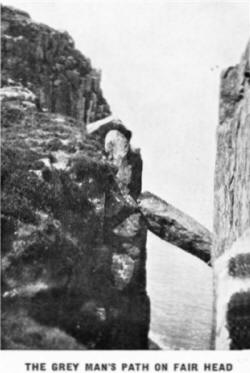 of the four, Fionnghuala, spending herself to warm and shelter her
brothers. At last they heard a bell from a Christian church, and resumed
their human form, but incredibly old. They were baptised and died and
buried in the one grave, with Fionnghuala in the middle, a brother on
either side, and her youngest brother in her arms that she might shelter
him as always. Moore has sung their story :
of the four, Fionnghuala, spending herself to warm and shelter her
brothers. At last they heard a bell from a Christian church, and resumed
their human form, but incredibly old. They were baptised and died and
buried in the one grave, with Fionnghuala in the middle, a brother on
either side, and her youngest brother in her arms that she might shelter
him as always. Moore has sung their story : "Sadly, O
Moyle, to thy winter wave weeping,
Fate bids us languish long ages away ;
For still in her darkness doth Erin lie sleeping
And still doth the pure light its dawning delay." While in Ballycastle
Knocklayde should be climbed and a walk taken to Armoy for the sake of
its Round Tower, nor could a visit to Bunamargy Abbey be neglected, in
whose graves were ended the loves and griefs of countless generations of
fierce and stormy hearts. Ballycastle is famous as a tennis centre,
the courts, oddly enough, being laid out in what was once a harbour. It
has good golf links, bathing, boating, and fishing�and life has few
pleasanter things to offer than a day along the Cary or the Shesk
rivers. Rathlin
Out at sea is Rathlin, where Robert Bruce took refuge after one of the
defeats which he avenged at last at Bannockburn, and no doubt Rathlin
still shelters descendants of the spider which taught him to "try, try
again." His victory, according to tradition, was foreseen and foretold
by an old woman of the island, who was so sure of it that she sent her
two sons with him to share in his coming good fortune :
"Within short time ye shall be king
And have the laud to your liking,
And overcome your foes all ;
But many annoyis thole ye shall
or that your purpose end have tane;
But you shall them outdrive ilkane," --the last line suggesting that
the old lady was a golfer. Rathlin has been the scene of three
frightful massacres �one by the clan Campbell of all the inhabitants of
the island�and for generations afterwards no Campbell dare put a foot on
its shores�the others by English forces warring against Macdonnell ; on
the second occasion over 600 were slain. Macdonnell saw the tragedy from
the mainland, and "was likely to run mad from sorrow, tearing and
tormenting himself and saying that he had then lost all he ever had."
The island is well worth visiting. There is a motor boat service between
Ballycastle and Rathlin on the Monday, Wednesday and Friday of each
week, tide and weather permitting.

Ballintoy,
From Ballycastle to Portrush one may still follow the coast past
Whitepark Bay, beloved by archaeologists, Kinbane, or White head, with
its fragment of castle, Grace Staples cave, something like the cave at
Staffa, and that famous spot Carrick-a-Rede, which means the "rock in
the road," that is in the road of the salmon. It is separated from the
mainland by a gap sixty feet wide, across which, ninety feet above the
sea, is a frail rope bridge, which to ordinary nerves is a fairly severe
test, though the fishermen can run across it and even carry sheep.
Nearby is Ballintoy, well worth noting as a little known beauty
spot and a delightful place for peaceful holiday-making, and for the
sake of the history and legend which may be found around it, as in the
ruins of Dunseverick Castle.
fragment of castle, Grace Staples cave, something like the cave at
Staffa, and that famous spot Carrick-a-Rede, which means the "rock in
the road," that is in the road of the salmon. It is separated from the
mainland by a gap sixty feet wide, across which, ninety feet above the
sea, is a frail rope bridge, which to ordinary nerves is a fairly severe
test, though the fishermen can run across it and even carry sheep.
Nearby is Ballintoy, well worth noting as a little known beauty
spot and a delightful place for peaceful holiday-making, and for the
sake of the history and legend which may be found around it, as in the
ruins of Dunseverick Castle. In the legends of the Red Branch Knights
of Ulster Dunseverick was the home of Conal Cearnac, so famous as a
wrestler and swordsman that with a band of comrades he pitted Irish
skill against Roman, both in Britain and in Rome itself, and was
victorious always. He then journeyed east and was in Jerusalem on the
day of the crucifixion. He was near the Cross when the soldier pierced
Christ's side, a drop of blood falling upon Conal's brow. He watched the
soldiers casting lots for Christ's seamless coat, and joining them, won
but refused to accept it. He was present at the burial, and it was he
pushed aside the stone when Joseph was opening the tomb for, the
reception of Christ's body
Another legend records the return of a Turlough O'Cahan from the
crusades just in time to find a Danish chieftain, Hakon, undergoing
baptism as a preliminary to marriage with Turlough's sister. Turlough,
enraged at the proposal cried, " You have come here for baptism. I will
baptise you with Greek fire." One can let the poet David Lindsay tell
the rest :
" Turlough, from beneath his cloak, raised a vase
above his head,
That descended, wrapping Jarl in
flames that quick as lightning spread.
Soon the
castle was on fire, and great were the alarms,
The
Norseman upon Turlough leaped and locked him in his
arms.
He tells him that he's now avenged they roll in
death's embrace,
I am avenged,' again he cries ; and both died in
that place.
The horror-stricken visitors fled down the deep
descent,
In haste to reach the causeway ; to cross was their
intent.
But the dreadful climax remains yet to be told
A
wild cry went up from the crowd at what they did behold
:
The lovely maiden, young and fair, being witness of
such woe,
Leans from the cliff. a hundred feet. to the
Seething waves below."
Saint Patrick once came to Dunseverick. The stone on which he sat has
disappeared, but the well from which he drank and to which he gave his
blessing, still flows at the foot of the adjoining cliff. And now,
after crossing the squat triangle on which are Bengore and Benbane
Heads, we come to the famous Giant's Causeway.

The
Giant's Causeway.
The Causeway is by some thought to be almost arm-in-arm with Portrush,
but it is some six miles away, a distance happily spanned by
electric tram�and it is worth remembering that the original tram was the
first in Great Britain on the hydro-electric principle. What can one say
about the Causeway ? " With skill so like, yet so
surpassing, art ;
With such design so just in every part :
That reason pauses, doubtful if it stand
The work of mortal or immortal hand."
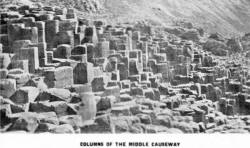 And
indeed legend has ascribed it to a mortal if giant hand, declaring it to
be the work of the famous Irish giant, Finn McCoul, though whether with
the object of allowing him to cross to Scotland or a Scottish rival to
cross to Ireland versions differ. That being so, it is better to stick
to the teachings of geology which ascribe it to those gigantic outbursts
of lava which did so mu And
indeed legend has ascribed it to a mortal if giant hand, declaring it to
be the work of the famous Irish giant, Finn McCoul, though whether with
the object of allowing him to cross to Scotland or a Scottish rival to
cross to Ireland versions differ. That being so, it is better to stick
to the teachings of geology which ascribe it to those gigantic outbursts
of lava which did so mu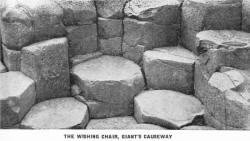 ch
to mould County Antrim. Dr. Talmage best describes the quality which
sets the Causeway apart : " You go to look at a celebrated lake, but you
have seen other lakes. You go to look at a high mountain, but you have
seen other mountains. You go to see .a great city, but you have seen
other cities. But there is nothing in the world like the Giant's
Causeway." That is its great quality. It is alone of its kind,
unexampled, unique, a miracle in shape, as if gigantic bees had been its
builders and their work had been in stone instead of wax. Here are many
things�the Little, the Middle and the Grand Causeway, Lord Antrim's
Parlour, the Organ, the Giant's Loom, the Giant's Well, the Gate-way,
the Wishing Chair, the Lady's Fan, and the Key-stone. Other things to be
seen are Portcoon Cave, Runkerry Cave, the Giant's Amphitheatre and
Pleaskin Head, with a series of pillars sixty feet high shaping the face
of the cliff, and no doubt a continuation of the Causeway. A
long-forgotten entertainment with a long-forgotten singer once put it
all into song : ch
to mould County Antrim. Dr. Talmage best describes the quality which
sets the Causeway apart : " You go to look at a celebrated lake, but you
have seen other lakes. You go to look at a high mountain, but you have
seen other mountains. You go to see .a great city, but you have seen
other cities. But there is nothing in the world like the Giant's
Causeway." That is its great quality. It is alone of its kind,
unexampled, unique, a miracle in shape, as if gigantic bees had been its
builders and their work had been in stone instead of wax. Here are many
things�the Little, the Middle and the Grand Causeway, Lord Antrim's
Parlour, the Organ, the Giant's Loom, the Giant's Well, the Gate-way,
the Wishing Chair, the Lady's Fan, and the Key-stone. Other things to be
seen are Portcoon Cave, Runkerry Cave, the Giant's Amphitheatre and
Pleaskin Head, with a series of pillars sixty feet high shaping the face
of the cliff, and no doubt a continuation of the Causeway. A
long-forgotten entertainment with a long-forgotten singer once put it
all into song :
" Then buy a box of specimens and take me for your
guide,
I'll point you out all to he seen along the Causeway side;
I'll lead you to the Magic Well and to the Giant's Chair�
And all will surely come to pass you wish when seated there.
Who'll give a shilling for a box ? I really wish to sell�
Do buy a box of specimens from little Irish Nell."
Bushmills and Portballintrae.
Leaving the Causeway en route for Portrush one comes to Bushmills, a
neat little town on the River Bush. The river is well known for its
salmon and trout fishing, and the town has also acquired a more than
local reputation for its production of a whiskey known to connoisseurs
as " Old Bushmills." Near Bushmills is the delightful seaside hamlet of
Portballintrae. As a quiet health resort it is ideal, and its sandy
beach a paradise for children. Dunluce Castle.
Halfway between the Causeway and Portrush, placed on a rock jutting into
the sea, are the ruins of Dunluce Castle, the most impressive on th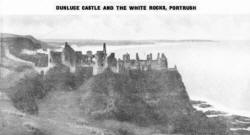 e
entire coast. It was held by and reft from McQuillans, O'Neills,
Macdonnells, and English garrisons, and in the reign of Elizabeth
finally, by grant from her, was confirmed as the possession of Sorley
Boy Macdonnell, the fiercest, most resolute, and most sagacious of his
race. One story of its capture is worth re-telling on the authority of
Sir John Perrot. When the Deputy, he says, "first took that pile he
placed a pensioner called Peter Cary to be constable of it, with a ward
of fourteen soldiers, thinking him to be of the English pale or race,
but afterwards found that he was of the north. This constable, reposing
trust in those of his country and kindred, had gotten some of them unto
him, and discharged the English soldiers unknown to the Deputy. Two of
these, having confederated with the enemy, drew up fifty of them by
night with ropes made of withies. Having surprised the castle, they
assaulted a little tower wherein the constable was and a few with him.
They had first offered them life and to put them in any place they would
desire (for so had the traitors conditioned with them before), but the
constable, willing to pay the price of his folly, chose rather to forego
his life in manly sort than to yield to any such conditions, and was
slain." e
entire coast. It was held by and reft from McQuillans, O'Neills,
Macdonnells, and English garrisons, and in the reign of Elizabeth
finally, by grant from her, was confirmed as the possession of Sorley
Boy Macdonnell, the fiercest, most resolute, and most sagacious of his
race. One story of its capture is worth re-telling on the authority of
Sir John Perrot. When the Deputy, he says, "first took that pile he
placed a pensioner called Peter Cary to be constable of it, with a ward
of fourteen soldiers, thinking him to be of the English pale or race,
but afterwards found that he was of the north. This constable, reposing
trust in those of his country and kindred, had gotten some of them unto
him, and discharged the English soldiers unknown to the Deputy. Two of
these, having confederated with the enemy, drew up fifty of them by
night with ropes made of withies. Having surprised the castle, they
assaulted a little tower wherein the constable was and a few with him.
They had first offered them life and to put them in any place they would
desire (for so had the traitors conditioned with them before), but the
constable, willing to pay the price of his folly, chose rather to forego
his life in manly sort than to yield to any such conditions, and was
slain." To this wild spot on the northern coast another Macdonnell,
the first Marquis of Antrim, brought his bride, widow of that Duke of
Buckingham who was assassinated by Felton in the streets of Portsmouth,
and thus Dunluce is strangely linked with D'Artagnan, Athos, Porthos,
Aramis, and Miladi and Richelieu and Anne of Austria and the other
children of history and the teeming mind of Dumas. It was in her time
and during preparations for a banquet that portion of the castle
collapsed into the sea, carrying with it to their death nine unfortunate
servants. A tinker who was sitting in a window escaped, and the "
Tinker's Window" is there till this day. But more and more ruin fell
upon the castle. It changed hands during the wars of 1641-9, and finally
the family seat was removed to Glenarm, where it is till this day.
" (trim fortress of the Northern Sea,
Lost are thy power and pride ;
Within thy undefended walls,
The folded sheep abide." One cannot leave the neighbourhood of Dunluce
without a reference to its connection with the Spanish Armada, still
commemorated in the name of the little cove Port-na-Spania. Here was
wrecked the Gerona, one of those gigantic galleys of the Armada which
carried fifty guns and were driven by oar. At the moment of the wreck
she was under the command of the famous Alonza da Leyva, who "was so
celebrated a personality, with so many attractions combined in him of
birth, bearing, and distinguished services, that of the fathers of the
high-born youths who had volunteered to accompany the Armada most of
them had committed their sons to da Leyva's special care." Already in
that great rout he had lost his first ship and his second, the latter on
the Irish coast ; but most of the company had been saved and made their
way to Killybegs, where they found the Gerona. It could take on board
only three hundred of the newcomers, and with this crowded vessel da
Leyva tried to reach the Scottish coast. But with the single vessel, as
with the great Armada, in the words of the Elizabethan medal, "Afflavit
et Dissipantur, "the Lord sent His wind and scattered them," a gale
broke, the oarsmen were utterly unable to keep the unwieldy vessel out
to sea, and so she drove ashore on this narrow spit. Only five, it is
said, survived ; the others perished, and some 260 bodies, including da
Leyva, were strewn upon the shore. The inevitable Macdonnells secured
some of the vessel's guns, which they mounted in Dunluce, and at least
one of the great iron treasure chests. What became of the guns has long
since passed out of knowledge, but the chest, one understands, is still
in the possession of the family at Glenarm.


Portrush.
Thus one comes to Portrush, of which one scarcely knows which is the
more famous�the Golf Links or the Blue Pool.
When both are so good, there is no need to quarrel over pre-eminence.
Portrush is, above all things. a health and holiday resort, and how long it has been noted as both may be judged from an advertisement of 1761 :
it has been noted as both may be judged from an advertisement of 1761 :
"At the house commonly called Bushfoot, where John Dunkins, Esq.,
usually lived, there will be lodgings kept for bathers or those who have
a mind to drink the salt water, by Edward Fayth. Any gentlemen or ladies
who will favour him with their company may depend on clean and orderly
attendance with a reasonable charge, his wife being an Englishwoman.
Also he will keep a cakehouse for those who pass by or repasses to the
Giants Causeway with cyder and mead, and a fish dinner will be dressed
for any that inclines to dine ; and those who come to bathe are desired
to give a week's warning to your most obedient humble servant, Edward Fayth. N.B.�He intends keeping of goats." Edward Fayth is long since a
handful of indistinguishable dust; so is his wife, whose nationality was
given as a pledge of cleanliness�a nasty jar to the natives of
yesterday�but their spirit goes marching on in the Portrush of to-day,
though we no longer have the taste of our ancestors for goat's whey.
Portrush it is a pretty place surrounded by the sea,
If it were cut from strand to strand an island it would be,"
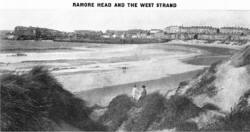 which
is the poet's way of saying it is built on a promontory some three
hundred feet wide and is washed on three sides by the Atlantic. The mere
site suggests fortification, and, when in the days of James I. it was
rented from the Macdonnell of the time by a Captain Phillips on a forty
years' lease at an annual payment of a hogshead of claret, the latter
was vastly pleased with his bargain. He had visions of fortifications
and of harbours which were to make it at once the key and the gate of
the north. Neither came to anything, and more than two centuries after
Phillips had been gathered to his fathers such emigrant ships�and they
were many�as called at Portrush had to lie off the Skerries which
is the poet's way of saying it is built on a promontory some three
hundred feet wide and is washed on three sides by the Atlantic. The mere
site suggests fortification, and, when in the days of James I. it was
rented from the Macdonnell of the time by a Captain Phillips on a forty
years' lease at an annual payment of a hogshead of claret, the latter
was vastly pleased with his bargain. He had visions of fortifications
and of harbours which were to make it at once the key and the gate of
the north. Neither came to anything, and more than two centuries after
Phillips had been gathered to his fathers such emigrant ships�and they
were many�as called at Portrush had to lie off the Skerries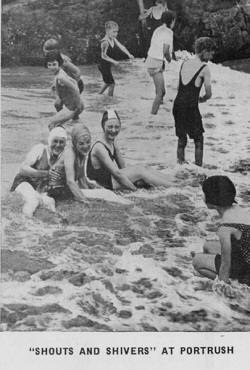 (those rocks to seaward) while the passengers and their gear were
carried out by boat. More important now than its defensive strength is
Portrush's salubrity, and the clean salt Atlantic winds are among the
best of physicians. Ramore Head, nearly flat on the top, but ending on
the west in a long range of steep cliffs, affords a magnificent view,
more extended than Dick Swiviller's "over the way." One can to the west
look over Derry into the hills of Donegal, northward to Scotland,
notably Islay and the Paps of Jura, and, turning east, to Cantire and
the hills of Arran, and down to Rathlin. Then there are walks along the
strands, the west, which is about a mile and leads to the Black Rocks,
and the east, about two miles long, leading to the White Rocks, carved
by the sea into fantastic shapes. Here are the " Lion's Paw," the "
Giant's Head," the " Wishing Well," and about twenty-seven caves, some
accessible afoot but the greater number only by boat.
(those rocks to seaward) while the passengers and their gear were
carried out by boat. More important now than its defensive strength is
Portrush's salubrity, and the clean salt Atlantic winds are among the
best of physicians. Ramore Head, nearly flat on the top, but ending on
the west in a long range of steep cliffs, affords a magnificent view,
more extended than Dick Swiviller's "over the way." One can to the west
look over Derry into the hills of Donegal, northward to Scotland,
notably Islay and the Paps of Jura, and, turning east, to Cantire and
the hills of Arran, and down to Rathlin. Then there are walks along the
strands, the west, which is about a mile and leads to the Black Rocks,
and the east, about two miles long, leading to the White Rocks, carved
by the sea into fantastic shapes. Here are the " Lion's Paw," the "
Giant's Head," the " Wishing Well," and about twenty-seven caves, some
accessible afoot but the greater number only by boat. At the foot of
Ramore Head are the recreation grounds, including greens for bowls and
putting, and hard and grass tennis courts. But it is for its golf that
the town is most famous, and its links are not afraid to challenge those
of St. Andrews. The course has long been on the championship rota, and
with its recent changes is better and more strenuous than ever. There is
also an eighteen-hole course for women. The Blue Pool has already been
mentioned in connection with bathing, and a more delightful spot and one
better fitted to test the diver it would be hard to imagine. The South
Pier is also notable, and there is in addition the Ladies' Bathing Place
on the east side as well as facilities for those who cannot swim. In
addition the L.M.S. authorities have built a large indoor sea-water
Swimming Pond, open to the public, Music and Refreshments being
available.
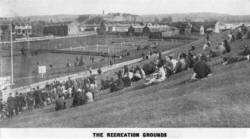 Portrush
has had its share of tribulations. It was destroyed in 1584 by Sir John
Perrot and again in 1642 by General Munroe, who razed both the castle
and church. Portrush did not begin to recover from this second disaster
till the beginning of the eighteenth century, when building once more
commenced. It is worthy of note that from 1642 till 1831 it had no place
of worship of any kind. Then a few of the Methodists got a grant of a
piece of ground from the Earl of Antrim, and built a chapel. Its bell
had a curious history. It was presented by Alexander I. of Russia to the
Duke of Newcastle ; by the latter given to the famous Dr. Adam Clark (a
notable divine, whose statue stands in the town), and by him to the
chapel. It has an inscription " 1681. Franciseur Legillon Mammes Fremy
Me Fecit Amster Dames." Surely a curious concatenation of people and
events. Portrush
has had its share of tribulations. It was destroyed in 1584 by Sir John
Perrot and again in 1642 by General Munroe, who razed both the castle
and church. Portrush did not begin to recover from this second disaster
till the beginning of the eighteenth century, when building once more
commenced. It is worthy of note that from 1642 till 1831 it had no place
of worship of any kind. Then a few of the Methodists got a grant of a
piece of ground from the Earl of Antrim, and built a chapel. Its bell
had a curious history. It was presented by Alexander I. of Russia to the
Duke of Newcastle ; by the latter given to the famous Dr. Adam Clark (a
notable divine, whose statue stands in the town), and by him to the
chapel. It has an inscription " 1681. Franciseur Legillon Mammes Fremy
Me Fecit Amster Dames." Surely a curious concatenation of people and
events. As Portrush is virtually at the western edge of County Antrim,
one turns one's back upon the sea and heads the car into the long road
which runs south-ward to Ballymoney.

Ballymoney.
Ballymoney, or rather the "Aenach- Cross," which a thousand years ago
preceded it, has known what it is to entertain kings and to be described
as Paradise. In the eighteenth century distinction was given to it by
two brothers, John and David MacBride, sons of the Pres-
byterian clergyman. John, entering the Navy in days when promotion
virtually depended upon birth and influence, rose through sheer force of
ability till when he died in the year 1800 he was Admiral of the Blue.
His was one of the vessels of Rodney's Fleet which beat the Spaniards
off Cape St. Vincent, and it was MacBride in the Bienfaisant of 64 guns
who captured the Spanish Admiral, Langara, in the Phoenix, of 84 guns.
It is worth mentioning as a nice example of the naval chivalry of the
day that MacBride allowed the Spaniards to remain prisoners on parole
aboard their own vessel as his was reeking with smallpox, and that the
Spaniards punctiliously observed the parole.
David, settling in Dublin, became a most distinguished physician, and,
no doubt because of his brother's profession, turned his attention to
scurvy, that immeasureable plague of countless generations of seamen. In
course of time he concocted what he called a "wort," an infusion of
herbs, some barrels of which Cook took on one of his voyages, with the
result that not a man died during that particular voyage. Within
comparatively easy reach is Dervock, near which, at a townland named
Conagher, was and is the ancestral home of President McKinley, one of
the very many men of Ulster descent who have attained the White House.
Ballymena.
Once again the car heads southward till it reaches Ballymena, the "City
of the Seven Towers," which is the geographical centre of the county.
Comparatively modern, the town originally owed its prosperity to the
linen manufacture introduced about 1732 by families named Adair and
Dickey. The former family, which now holds a baronetcy, is still
associated with the district, and it is probable that the " Fortunate
Irishman " of the eighteenth century, the happy-go-lucky doctor with
whom Admiral Keppel's daughter fell in love (with as one result the
beautiful song " Robin Adair "), was one of them. The most exciting
incident in Ballymena's history was no doubt the battle which took place
in its streets during the "turnout" of '98. It was, to use an Ulster
phrase, a very "throughother" affair, reflecting little credit on the
courage, the military skill, or the discretion of the insurgents. The
town was in their possession for three days, after which the news of the
defeats of their comrades elsewhere reached them, when there was a swift
and almost general dispersal. Ballymena is the nearest railway station
to Slemish, which, as already mentioned, was the scene of St. Patrick's
activity, also within easy reach are Kells, which contains the remains
of an Abbey (not to be con-founded with the more famous Kells in
Southern Ireland) ; and Gracehill, a Moravian settlement founded in
1765. The Valley of the Braid may be mentioned as one of the most
fertile and placidly beautiful districts in the north. Ballymena, it
may be worth recalling, was the home of William Herbison, the " Bard of
Dunclug," one of the many Ulster peasant poets who took to verse largely
because Burns had been a peasant and a poet before them.
Antrim.
 From
Ballymena to Antrim there is a choice of routes�the one direct, the
other through Toome, at the exit of the River Bann from Lough Neagh. In
the old fighting days it was one of the most important river crossings
In Ulster ; now it is chiefly notable as a centre of the eel fisheries
of the lough. From Toome one passes to Randalstown, which although it
lay in O'Neill territory was. amazing as it may seem, named after a
Macdonnell ; and so, still skirting Lough Neagh, the car comes to
Antrim, also on the lough. Not so much is heard nowadays of the From
Ballymena to Antrim there is a choice of routes�the one direct, the
other through Toome, at the exit of the River Bann from Lough Neagh. In
the old fighting days it was one of the most important river crossings
In Ulster ; now it is chiefly notable as a centre of the eel fisheries
of the lough. From Toome one passes to Randalstown, which although it
lay in O'Neill territory was. amazing as it may seem, named after a
Macdonnell ; and so, still skirting Lough Neagh, the car comes to
Antrim, also on the lough. Not so much is heard nowadays of the "
Lough Neagh hones! Lough Neagh hones!
You put 'em in sticks and you take 'em out stones," from a former
belief in the petrifying qualities of the water. It was even said that
the fishermen had no need to buy hones for their razors, as all they had
to do was to turn up their trousers and sharpen the blades on their
shins. Antrim is one of the most interesting little towns in the
north, and rare, if not unique, in being now a couple of miles from its
original site. It has, moreover, one of the only two perfect Round
Towers in Ulster, the other being on Devenish Island, in Lough Erne. It,
too, was the scene of a battle in '98, and the insurgents being led by
Henry Joy McCracken himself, one of the chiefs, the fighting here was
severe though it had the usual ending. It may be added that McCracken, a
young and honest enthusiast of whom one can only speak with respect, was
afterwards hanged in the High Street of Belfast, from the Market House,
which had been the gift, or so it is said, of his family to the town.
The little town has a happier memory in being the first place in Ireland
where the principles of the Society of Friends were advocated, its and
Ulster's first Quaker being a William Edmundson, of whose journal Wesley
wrote : ` His opinions I leave ; but what a spirit was there ! What
faith, love, gentleness, long-suffering ! Could mistakes send such a man
as this to hell ? Not so. I am so far from believing this that I
scruple not to say, ' Let my soul be with the soul of William Edmundson.'
" Antrim has had other notable figures of various denominations, and one
cannot but be charmed with a poetic tribute to one of them, a Mr.
Abernethy :
He was a bright and luminous preacher,
A
sound and honest moral teacher.
He knew the system of creation
Better
than most men of the nation --
And sat
sedately at his ease
And ate his butter,
bread and cheese."
Coming to the present day, the cottage in which was born Rev.
Alexander Irvine, D.D., author of that poignant Irish peasant life story
" My Lady of the Chimney Corner,' and other works, who, by his own
efforts, rose from a newspaper boy, is in Pogue's Entry, off Church
Street, where a memorial has been erected to his parents.

In the old graveyard at Donegore, a few miles from Antrim, was buried
Sir Samuel Ferguson. one of the most considerable Irish poets prior to
Yeats. Ferguson, by the way, being born in High Street, Belfast, where a
plaque marks the house. Other persons connected with the town have
been Owen O'Connelly, who first gave information about the intended
rising of 1641, and thus was the means of preventing Dublin Castle from
capture ; Sir John Clot-worthy, one of the eleven Presbyterian Members
of the House of Commons in Cromwell's day who were impeached for their
opposition to those who had seized King Charles and were about to try
him for treason. The Rev. William King, Archbishop of Dublin, was the
son of an Antrim tradesman. Those who do any flying in Ulster know
Aldergrove, an R.A.F. centre, some four miles from Antrim, and the
training ground of Ulster's Auxiliary of the Air Force. Fishing is to
be had near the town in the Maine and the Six Mile Rivers. The
Massereene Golf Club has a pretty nine-hole course along the shores of
the lough. There are tennis clubs at Antrim and Muckamore nearby, both
open to visitors. From Antrim the car runs, still southward, through
Crumlin, a village whose name means " Crooked Glen," and Glenavy,
another village, whose name, properly Lanaway, indicates the " Church of
the Dwarf " from a diminutive cleric installed here by St. Patrick. Not
far away is Crewe Hill, on which the Kings of East Ulster (Ulidia) used
to be crowned, and where, in the year 1005, one of them and no less a
person than Brian Boru, High King of Ireland, exchanged courtesies and
gifts�or possibly dues. Brian gave the Ulsterman 1,200 horses, receiving
in his turn 1,200 oxen, 1,200 pigs and 1,200 sheep�which seems a
somewhat unequal barter. Passing Ballinderry, famous for its onions�"As
strong as a Ballinderry onion " is an Ulster simile�one runs into the
compact town of Lisburn.
Lisburn
As a town owes its foundation to a Sir Fulke Conway, to whom the
district was granted about 1609, and its prosperity to the establishment
of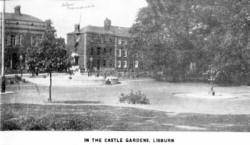 the linen trade here in 1698 by Louis Crommelin, a French Huguenot
refugee appointed by William III. to organise the entire linen industry
of Ireland. The town was twice destroyed, first in the war of 1641,
when, however, the Irish Army was defeated (a long account of the battle
is contained in the Cathedral register), and the second time in 1707 by
an accidental fire, when the castle, the church and the whole town were
reduced to ashes.
the linen trade here in 1698 by Louis Crommelin, a French Huguenot
refugee appointed by William III. to organise the entire linen industry
of Ireland. The town was twice destroyed, first in the war of 1641,
when, however, the Irish Army was defeated (a long account of the battle
is contained in the Cathedral register), and the second time in 1707 by
an accidental fire, when the castle, the church and the whole town were
reduced to ashes. Many famous men have been associated with Lisburn.
They include Louis Crommelin, already mentioned, whose work fructifies
in Ulster till this day. Here also as Bishop of Down and Connor lived
Jeremy Taylor, the great English divine, author of " Holy Living" and "
Holy Dying," who also died in Lisburn, though, curiously enough, he was
buried in Dromore. An interesting ruin connected with his ministry is to
be seen at old church, Ballinderry, on the shores of Portmore Lake. But
greatest of all Lisburn's great figures was Nicholson of Delhi, a true
native in that his parents were Lisburn people and part of his youth was
spent in the town, though he was not, despite the inscription on his
statue, born there but in Dublin. " Rare gifts had marked him for great
things in peace and war," says the tablet in the Cathedral. " He had an
iron mind and frame,
a terrible courage, an indomitable will. His form seemed made for an
army to behold, his heart to meet the crisis of an empire." In that
great "crisis of an empire," the Indian Mutiny, the part played by
Ulstermen�by Nicholson at Delhi, Henry Lawrence in Lucknow, John
Lawrence in the Punjab�should be remembered while one British foot
treads Indian soil. Of smaller and yet noteworthy people associated with
Lisburn mention should be made of the Rev. Philip Skelton, an eighteenth
century clergyman, a man of many eccentricities, but one of the very few
real Christians in that very venal age ; W. H. Betty, the " Infant
Roscius," to see whose acting as a child Pitt adjourned the House of
Commons ; and Sir Richard Wallace, who gave to the nation Hertford House
and its collection of pictures. Nor should one forget Henry Bayly, who
just a century ago immortalised Lisburn in verse that is unique in
English literature as a description of a British town :
" No snakes, nor toads, nor adders here
abound,
To fill with venom dire the
smiling ground ;
No wolves or bears here panting range
the plain
For human blood, the fertile soil to
stain ;
No ravenous lions here are heard to roar
With flaming tongues, which thirst for
human gore ;
No serpents with a poisonous
hiss are here
To strike the traveller with dread and
fear ;
(On these blest plains, oh ! never
may they roam,
Except when critics damn for trash my
poem !)
The town is fortunate in possessing such amenities as the Castle
Gardens and Wallace Park, the latter containing cricket, tennis and
bowling grounds. There is, moreover, an excellent nine-hole golf course
within five minutes' walk of the centre of the pleasant town. Fishing
may be had in the Rivers Lagan and Ravarnette, and also in the lake at
Ballykeel.

And so the traveller has now but a few miles to run and he is back in
Belfast, his tour of Antrim completed, and here not a tithe has been
told of its interest. As a large part of this journey has been made by
car it is not inappropriate to relate that the very first car to be put
on the road, certainly in Ulster and almost as certainly in all Ireland,
was driven and owned and had been built by a County Antrim man, and that
as far back as the year 1836. It was the handiwork of Rowan, of a famous
foundry, who drove it through Belfast on the 5th January, the band of
the 46th Regiment preceding it. It was, needless to say, a steam coach ;
it had two engines, each of ten horse-power; its boilers were water
tubes ; it carried twenty-eight passengers, and it could travel at
fifteen miles an hour. In another year every motorist of Ulster ought to
celebrate its centenary. A word or two might be added of some of the
famous men who have been the offspring of County Antrim. Among churchmen
these would include the Archbishop King and Philip Skelton, already
mentioned. Scientists will know the names of Joseph Black, one of the
pioneers of modern chemistry and an intelligible theory of heat, and the
still living Joseph Larmor, so long the secretary of the Royal Society.
Soldiers include the towering figure of Nicholson of Derry ; of Sir
Charles Rowan, who fought in Wellington's campaigns, and later became
the first chief of Peel's new police, and did so much to reconcile the
public to the " Peelers " ; his brother, Sir William, also one of
Wellington's men, who died a Field Marshal. Poets would include Sir
Samuel Ferguson and Dr. Drennan, It was Drennan who first christened
Ireland the " Emerald Isle" in a poem written in 1795.
" When Erin first rose from the dark swelling
flood,
God blessed the green island, He saw it was good
;
The Emerald of Europe, it sparkled, it shone,
In the ring of the world the most precious
stone.
" Arm of Erin, prove strong ; but be gentle as
brave,
And, uplifted to strike, still be ready to save
;
Nor one feeling of vengeance presume to defile
The cause or the men of the Emerald Isle."
Art supplies the name of Patrick MacDowell, the sculptor, and of Sir
John Lavery, the painter, and medicine and surgery the two MacCormacs,
father and son. There are many more. The list could be indefinitely
extended. But we in County Antrim are a somewhat curiously modest lot.
We are so conscious of our worth that we do not care who doesn't know
it.
 |